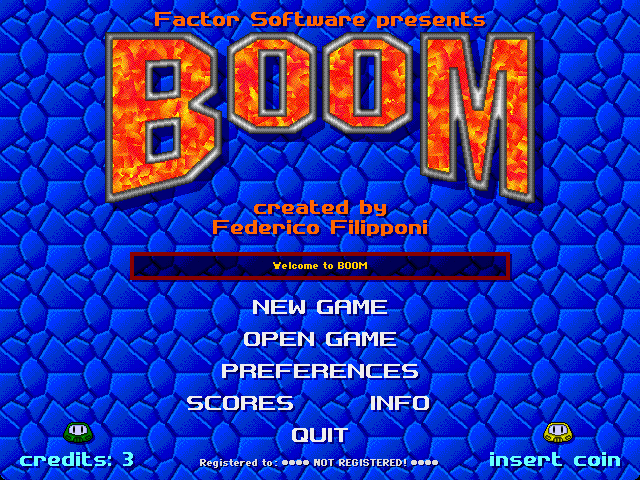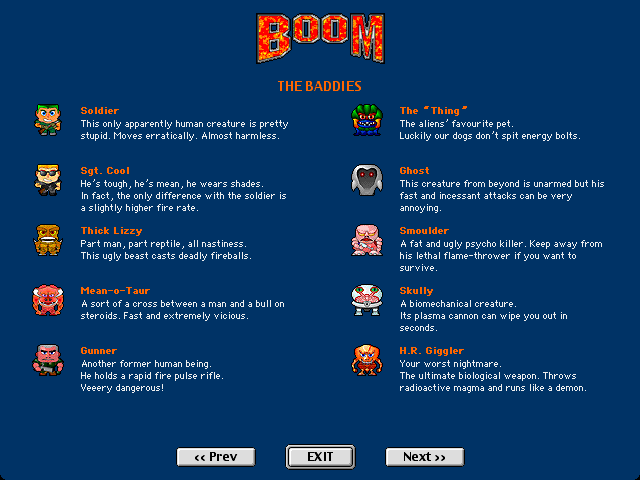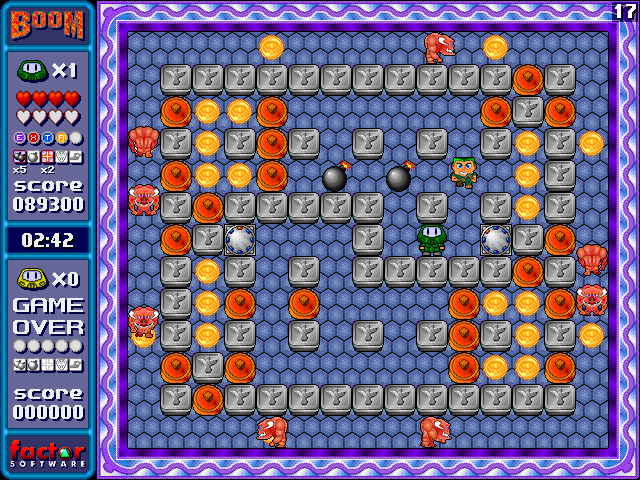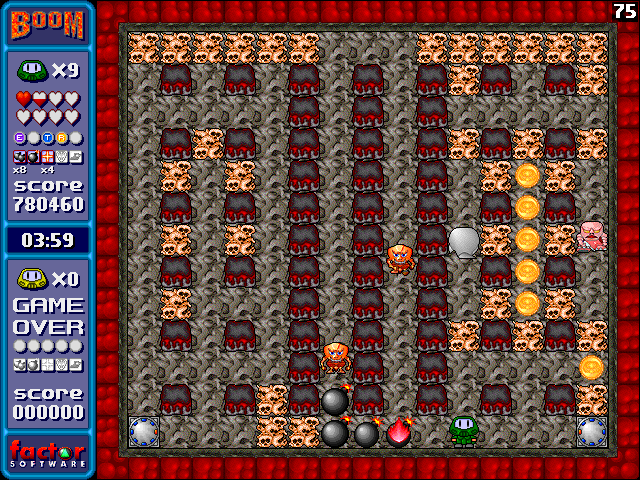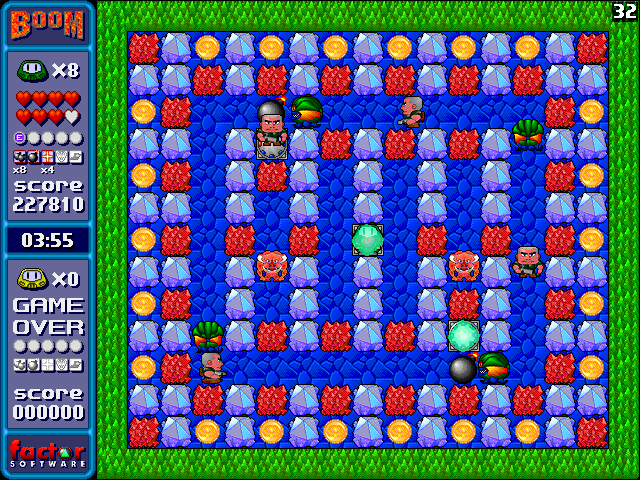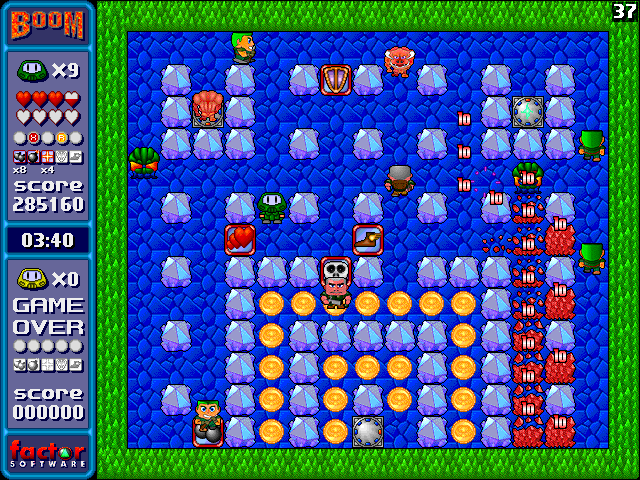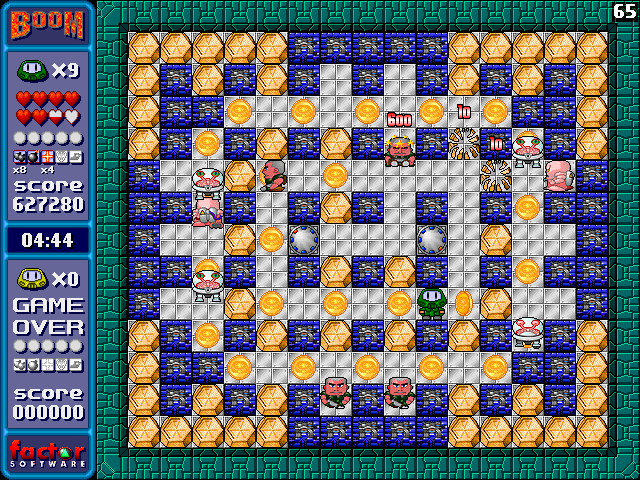Boom – Factor Software - 1997 - First time playing?: Played shareware version as a kid, first time playing past the first few levels
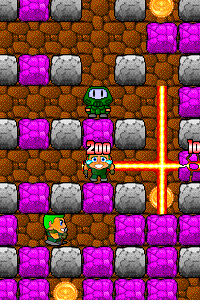 Demonic creatures from space have invaded earth and it's all up to one green-armoured space marine to… wait a second.
Demonic creatures from space have invaded earth and it's all up to one green-armoured space marine to… wait a second.
As you likely already caught onto if you're retro game savvy, Boom is essentially a Doom fangame with the gameplay style of Bomberman, not to be confused with the DOS source port of Doom also called Boom. At first glance this could easily be mistaken for another shareware clone of a classic arcade game that does little to differentiate itself from the source material, akin to Apeiron from last review, but that's doing Boom a hell of a disservice. While it sticks to the general premise of grid based levels you plant bombs in to dispatch enemies while trying to not blow yourself up, quite a few seemingly insignificant quirks and deviations from the standard Bomberman conventions result in a game that feels surprisingly distinct from its inspiration in pacing and how the level design accommodates its mechanics, while the Doom fangame aspects and seeing those demonic creatures and certain environments reimagined in such a cutesy way adds a bit of extra charm on top of it all. Though honestly, Doom demons are already pretty damn cute. Who doesn’t want to pet the cacodemon?
 Surprisingly this actually was a shareware game with a paid registration fee, not a freeware release like most fangames are now to avoid legal issues, and I can't help but wonder if this kinda thing would fly in 2023. Boom does the bare minimum to ensure that its characters are legally distinct such as renaming all the demons, calling them aliens and more dramatically redesigning some of the more iconic demons as as Boom's green and blue cacodemons with two eyes. Meanwhile however, the zombiemen, imps and pinkies are all immediately recognisable. The name changes could have felt like a lame cop-out but the ridiculous titles these creatures have such as "Sgt Cool", “Thick Lizzy” and "H.R. Giggler" end up working for the light and comical chibi reimagining of the Doom setting. No blood and gore or ripping and tearing here, just an endless supply of cartoon bombs from the ACME corporation to raise hell with. Something interesting about the shareware version is that it’s actually the full game with the only restriction being that you can’t save, thus requiring you to play through the whole game’s 80 levels in one sitting with only three credits. In the spirit of that, many who grew up with Boom and couldn’t get their hands on the registered version for one reason or another aim to beat the game under those same restrictions. Meanwhile, um, I’m a coward, so I absolutely played the registered version and saved at the start of every level.
Surprisingly this actually was a shareware game with a paid registration fee, not a freeware release like most fangames are now to avoid legal issues, and I can't help but wonder if this kinda thing would fly in 2023. Boom does the bare minimum to ensure that its characters are legally distinct such as renaming all the demons, calling them aliens and more dramatically redesigning some of the more iconic demons as as Boom's green and blue cacodemons with two eyes. Meanwhile however, the zombiemen, imps and pinkies are all immediately recognisable. The name changes could have felt like a lame cop-out but the ridiculous titles these creatures have such as "Sgt Cool", “Thick Lizzy” and "H.R. Giggler" end up working for the light and comical chibi reimagining of the Doom setting. No blood and gore or ripping and tearing here, just an endless supply of cartoon bombs from the ACME corporation to raise hell with. Something interesting about the shareware version is that it’s actually the full game with the only restriction being that you can’t save, thus requiring you to play through the whole game’s 80 levels in one sitting with only three credits. In the spirit of that, many who grew up with Boom and couldn’t get their hands on the registered version for one reason or another aim to beat the game under those same restrictions. Meanwhile, um, I’m a coward, so I absolutely played the registered version and saved at the start of every level.
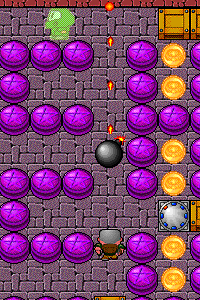 So, what are those mechanical differences? First off, unlike classic Bomberman where you die in one hit, in Boom you have a health bar, and a sizable one at that. 20 hit points total, however stronger enemies can do more than one hit point of damage, and your bombs remain a one hit kill if you get caught in the blast. To balance this significantly wider margin for error, Boom's enemies are much more aggressive. In addition to just being faster and more persistent in chasing you down, most enemies have some form of projectile weapon and will fire on sight, requiring you to quickly take cover behind walls to dodge speeding bullets that you're not fast enough to outrun. Yet another disadvantage you have to work with is the fact that bombs aren't solid objects here. In Bomberman you can frequently use bombs for defence as well as offence, most enemies can't walk through a placed bomb and you can use that to save yourself from getting cornered or block some projectiles. In Boom, both you and your enemies can walk and shoot straight through your bombs as if they're not even there, which does mean you can never trap yourself in a dead end with a lit bomb which is appreciated, but also means that your only defence is running and taking cover. Enemies are however incapable of passing through one another, so if two enemies collide then they’ll both turn around and start walking in the opposite direction, which is something that can also be used to your advantage. Finally, your bombs can only destroy blocks at point blank range, the extended reach of your bomb’s explosion is not strong enough to destroy blocks no matter how many powerups you have.
So, what are those mechanical differences? First off, unlike classic Bomberman where you die in one hit, in Boom you have a health bar, and a sizable one at that. 20 hit points total, however stronger enemies can do more than one hit point of damage, and your bombs remain a one hit kill if you get caught in the blast. To balance this significantly wider margin for error, Boom's enemies are much more aggressive. In addition to just being faster and more persistent in chasing you down, most enemies have some form of projectile weapon and will fire on sight, requiring you to quickly take cover behind walls to dodge speeding bullets that you're not fast enough to outrun. Yet another disadvantage you have to work with is the fact that bombs aren't solid objects here. In Bomberman you can frequently use bombs for defence as well as offence, most enemies can't walk through a placed bomb and you can use that to save yourself from getting cornered or block some projectiles. In Boom, both you and your enemies can walk and shoot straight through your bombs as if they're not even there, which does mean you can never trap yourself in a dead end with a lit bomb which is appreciated, but also means that your only defence is running and taking cover. Enemies are however incapable of passing through one another, so if two enemies collide then they’ll both turn around and start walking in the opposite direction, which is something that can also be used to your advantage. Finally, your bombs can only destroy blocks at point blank range, the extended reach of your bomb’s explosion is not strong enough to destroy blocks no matter how many powerups you have.
All of these changes likely sound immensely mundane, but the combination of these tweaks end up influencing all of Boom’s design, from the level design to the enemy AI. Bomberman is primarily about trapping enemies until the powerups you’ve collected allow you to cause more widespread mass destruction, but as we’ve established trapping enemies isn’t an option in Boom, plus the powerups, while still very useful in Boom, aren’t as potentially game-breakingly powerful as combinations of Bomberman’s remote bombs and bomb kicks and so on. The minimum equipment you have in Boom when you start the game or lose a life is the ability to plant five bombs at once with a blast radius of two tiles, and those two stats can only be upgraded three times each before they hit their cap, as opposed to Bomberman where you can keep upgrading your bombs until they’re powerful enough to fill the whole screen. Your strength in terms of power-ups doesn’t fluctuate nearly as much here, and as such your overall power is more consistent and allows for more puzzle-driven level layouts based around that smaller scale firepower.
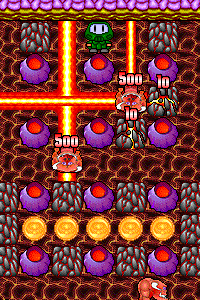 Blocks being used for cover is even more important here than it already was in Bomberman. Since even the weakest and most common enemies have guns, it’s not only your own blasts that you need to hide from, but also enemy fire as well. Plus you don’t have the ability to take cover behind a bomb, as previously mentioned, so having blocks between you and the enemy is your only defence. Destroying the wrong blocks in the wrong order can end extremely badly, with you getting overwhelmed by enemies you don’t have the room to manoeuvre around and giving their projectiles more clear shots at you. This is why it’s a good thing in Boom’s case that bombs can only destroy blocks at point blank range, as it prevents unintentional destruction of blocks that you really need to stay in tact for the meanwhile, as well as preventing you from having less control over what blocks you destroy as you power up the blast radius of your bombs.
Blocks being used for cover is even more important here than it already was in Bomberman. Since even the weakest and most common enemies have guns, it’s not only your own blasts that you need to hide from, but also enemy fire as well. Plus you don’t have the ability to take cover behind a bomb, as previously mentioned, so having blocks between you and the enemy is your only defence. Destroying the wrong blocks in the wrong order can end extremely badly, with you getting overwhelmed by enemies you don’t have the room to manoeuvre around and giving their projectiles more clear shots at you. This is why it’s a good thing in Boom’s case that bombs can only destroy blocks at point blank range, as it prevents unintentional destruction of blocks that you really need to stay in tact for the meanwhile, as well as preventing you from having less control over what blocks you destroy as you power up the blast radius of your bombs.
When it comes to fighting enemies, baiting is the primary tactic here. You don’t want to get too close to enemies or else you’re going to have to deal with point blank gunfire in your adorable space marine face, but that can also be used to your advantage. Many enemies will turn around to fire at you when there’s a clear line of fire between you and the enemy’s back, which can be used to throw an enemy off their aimless wandering prior to detecting you, leading them into a bomb about to detonate. Other enemies are melee focused but much faster to accommodate for that, in which case long corridors without branching paths are your best bet. The second you see a Mean-o-Taur/Pinky going down a long hallway with nothing in the way to throw them off course, planting a bomb at the end of that tunnel is a surefire way to have them charge straight into their demise. Has to be said, in contrast to the Pinkies in Doom which I’ve always found to be the easiest demon to deal with in that entire game, the Mean-o-Taurs in Boom are utterly ruthless, moving as fast as Boomguy and having a knack for staying on top of your sprite and not giving you any chance to run away. Even the H.R. Gigglers by the end of the game didn’t give me nearly as much trouble, mainly due to the level design giving you much more suitable choke points for fighting them in.
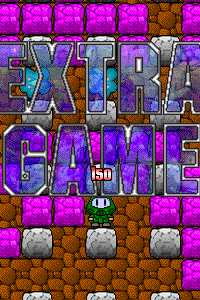 Another mechanic that’s unique to Boom is the coins and E-X-T-R-A letters. There’s a ton of coins scattered throughout every level and if you collect them all this activates Extra Game mode. During this mode every enemy on screen temporarily transforms into the same generic alien slime creature, during which they lose their projectile attacks and also drop one of the five letters required to spell EXTRA upon defeat. If an alien drops a letter you already have, you can wait for it to turn to another letter before collecting it, the letter won’t despawn until Extra Game mode ends. Spelling EXTRA is how you obtain extra lives and ends up creating a risk vs reward system. Obviously you’ll get the chance to collect the most letters and get the most lives if you avoid killing enemies as much as possible until Extra Game mode, but since the coins are spread across the whole level you’ll be putting yourself in danger and destroying your defences in the process, requiring you to balance fighting off enough enemies to not die while also leaving enough alive to get extra lives once you collect all of the coins, or even accepting that the coin placements in certain levels are more risk than they’re worth and to simply prioritise survival. It’s a neat system that adds yet another layer of strategy to consider that’s unique to Boom.
Another mechanic that’s unique to Boom is the coins and E-X-T-R-A letters. There’s a ton of coins scattered throughout every level and if you collect them all this activates Extra Game mode. During this mode every enemy on screen temporarily transforms into the same generic alien slime creature, during which they lose their projectile attacks and also drop one of the five letters required to spell EXTRA upon defeat. If an alien drops a letter you already have, you can wait for it to turn to another letter before collecting it, the letter won’t despawn until Extra Game mode ends. Spelling EXTRA is how you obtain extra lives and ends up creating a risk vs reward system. Obviously you’ll get the chance to collect the most letters and get the most lives if you avoid killing enemies as much as possible until Extra Game mode, but since the coins are spread across the whole level you’ll be putting yourself in danger and destroying your defences in the process, requiring you to balance fighting off enough enemies to not die while also leaving enough alive to get extra lives once you collect all of the coins, or even accepting that the coin placements in certain levels are more risk than they’re worth and to simply prioritise survival. It’s a neat system that adds yet another layer of strategy to consider that’s unique to Boom.
Aside from the obvious comparisons of Bomberman and Doom, there’s another game that Boom reminds me of, and that’s Bubble Bobble of all things. Obviously they’re both single screen elimination-focused arcade games, plus the mechanic of collecting the letters to spell out E-X-T-R-A to earn an extra life is right out of Bubble Bobble with its E-X-T-E-N-D letters serving the same purpose, but it’s more the level design that makes me think of Bubble Bobble. Both games start out as fairly straightforward action arcade affairs but get more and more complex and puzzle-like as you progress, while still being based around the same simple mechanics. Frequently the levels in these games have something of an intended route for you to figure out, and while the level won’t be unwinnable if you deviate from that route by rushing in or by not figuring it out in time, it’s still going to make things a lot harder for you. Through more replays you start to see more of the intended strategies and figure out more reliable paths through dangerous levels.
This style of level design does have its significant drawbacks in both cases unfortunately. Bubble Bobble would very commonly throw you into levels where if you don’t immediately act the second you gain control you’ll throw yourself off that intended route, and while Boom doesn’t do that nearly as frequently thanks to most levels starting you in a safe spot behind blocks that enemies can’t pass through, there’s also a handful of levels that use teleporters in a way to immediately throw you into danger. If you spawn in next to a teleporter you’ll need to act ASAP, especially if you’re in a cramped enclosed space. The Boomslayer can enter teleporters that transport him to another linked teleporter in the same level, but enemies can also use those teleporters, and all it takes is one Mean-o-Taur stumbling their way into the teleporter linked to your starting position to immediately decimate you. Since most of the enemies behave pretty aimlessly and unpredictably until they see you, it also adds a level of inconsistent difficulty to these stages as sometimes they’ll completely ignore the teleporters and give you plenty of time to get your bearings, while other times their random pathfinding is not on your side and they immediately all pour in one after another and completely swarm you in your enclosed starting room that consists of seven whole tiles.
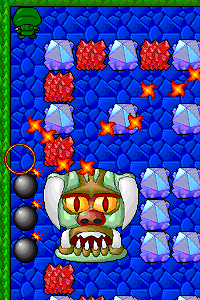 Another criticism I have are the bosses. Um, all two of them. You fight a boss every ten levels, but seven times out of eight it’s the exact same stationary Icon of Sin-esque demon face that shoots volleys of projectiles from its mouth. First boss you fight one of them, second boss you fight two of them at the same time, third boss has three at the same time, then you have to fight three but with regular enemies thrown into the mix too, so on and so on. The strategies required for fighting each incarnation of this recurring boss is varied, don’t get me wrong, you’re fighting each version in a slightly different way thanks to the level design and enemy placement throwing your past route off-course, but it still feels pretty weak compared to Bomberman’s varied and creative bosses. Thankfully the final boss is original at least, preventing every boss from being a retread.
Another criticism I have are the bosses. Um, all two of them. You fight a boss every ten levels, but seven times out of eight it’s the exact same stationary Icon of Sin-esque demon face that shoots volleys of projectiles from its mouth. First boss you fight one of them, second boss you fight two of them at the same time, third boss has three at the same time, then you have to fight three but with regular enemies thrown into the mix too, so on and so on. The strategies required for fighting each incarnation of this recurring boss is varied, don’t get me wrong, you’re fighting each version in a slightly different way thanks to the level design and enemy placement throwing your past route off-course, but it still feels pretty weak compared to Bomberman’s varied and creative bosses. Thankfully the final boss is original at least, preventing every boss from being a retread.
One last thing to praise here to bring things back to positivity before wrapping this review up however is the soundtrack. I adore Boom’s music, it absolutely nails sounding suitable for both Bomberman and Doom at once and its high-tempo upbeat melodies are utterly infectious. The music from levels 1-10 getting stuck in my head was what reminded me of Boom’s existence and made me decide to play through it in full for the first time, and the rest of the soundtrack that I had never heard before didn’t disappoint either. A lot of the later level themes switch mid-track between midi guitar riffs right out of Boom and playful synth more befitting of a Bomberman game and it’s genuinely impressive how smoothly the soundtrack can balance both radically different styles in a way where each compliments each other. Highly recommended listening if you don’t mind your audio quality crunchy.
You may have noticed that I never mentioned any kind of battle mode, and if that’s the make or break feature of Bomberman games for you then I’m afraid to say the only multiplayer here is two–player co-op through the main campaign. Honestly, not a huge loss in my opinion, as controversial a statement as that may be, Boom’s mechanics aren’t really suited for that style of gameplay, plus huddling around a computer isn’t really ideal for a party game like Bomberman. The co-op multiplayer however is a lot of fun, always found that an underrated feature in games like Saturn Bomberman. Overall, Boom is an excellent spin on the Bomberman formula well thought out and executed, some occasional cheap levels aside, and well worth a look. Whether or not it’s better or worse than Bomberman becomes irrelevant since it’s doing enough different that it stands on its own merits with design philosophies that would only work specifically for Boom, and I think that’s commendable, it’s what makes it still worth playing even in 2023. Factor Software have since closed shop, but indie developer silverweed has since released a modern 64bit fan made remake of Boom that’s pretty faithful and well done from what I've played. Click here to check it out!
- Page written by MSX_POCKY, 25th September 2023
